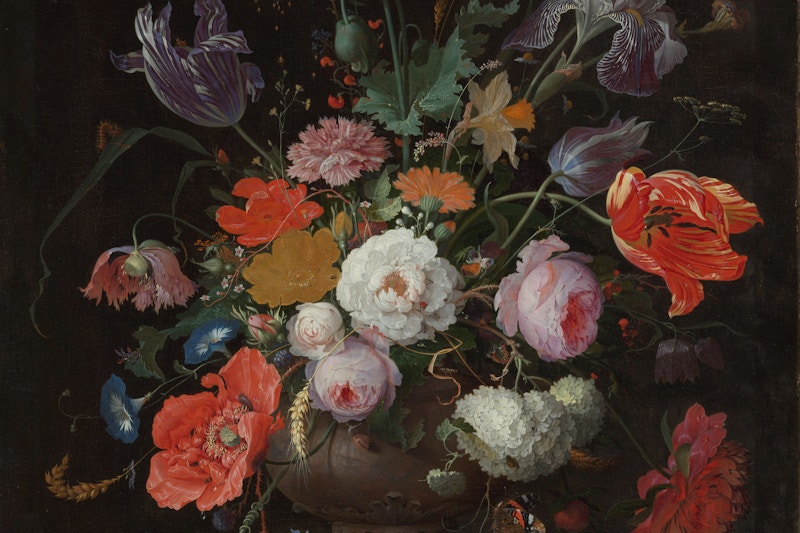
The Musical Still Life: Exploring the Development of Instrumental Iconography in 17th-Century Italian Art
Maurizio Canesso and Véronique Damian of Galerie Canesso discuss these striking Old Master paintings from the musical centers of Northern Italy
- By Karen Chernick
- Meet the Experts
The Stradivarius violins crafted in the Cremonese workshop of Antonio Stradivari are believed, by many, to produce sounds unparalleled in their brilliance. Whether true or not, it is certain that Stradivari was one of many celebrity luthiers active in Northern Italy during the Baroque period. The region where he and his equally famous predecessor, Nicolò Amati, made violins dominated the production of specialty stringed instruments during the 16th and 17th centuries.
Complementing this mastery, for as long as instrument makers have headquartered in Lombardy and the surrounding provinces, there have also been painters committing lutes, violins, spinets, and chitarrinos to canvas. This Italian tradition began with Venetian artists such as Titian painting musical performances in works like his Pastoral Concert (c. 1509) and The Concert (1510–11). At the same time, artists such as Sebastiano del Piombo and Dosso Dossi incorporated musical instruments as props in their portraits and mythological paintings. Further south, Roman artists Caravaggio and his follower Cecco del Caravaggio embellished their paintings with instruments.

Caravaggio, Lute Player, 1595-96. Oil on canvas. 94 x 119 cm (37 x 46.9 in.). Collection The State Hermitage Museum, St. Petersburg.
The Lucchese painter Pietro Paolini began shifting this tradition around the mid-17th century, with several portraits of craftsmen making instruments. These works were unusual since their instruments were still being made, and therefore silent. Roughly a decade later, instrument makers and musicians disappeared altogether on the canvases of a painter in Bergamo. Within these extraordinarily detailed still lifes by Evaristo Baschenis (1617–1677), only the instruments remain.
“That is an invention of Baschenis,” explains Maurizio Canesso, founder of Galerie Canesso specializing in Italian Renaissance and Baroque paintings, which mounted a 2022 solo exhibition for Baschenis at its Parisian gallery. “He put his instruments in a large, wide space that seems to be in a suspension. The instruments are generally face down, as if to say the music is over. In some there is dust that takes many years to gather.”
Baschenis pioneered the musical still life, unusual for that genre but also not surprising given that he lived amidst a thriving musical industry. The number of instrument workshops swelled in 17th-century Italy, with most concentrated in Lombardy and the north (Venice had 91 active workshops, Cremona and Milan each had 71, and Brescia had 49). Between 1500 and 1700 there were 850 luthiers scattered between 115 Italian cities, producing new instruments and decorative enhancements to match their sound quality, such as ivory inlay.

Evaristo Baschenis, Still Life with Musical Instruments, Books, and Sculpture, c. 1650. Oil on canvas. 124 x 94 cm (48.8 x 37 in.). Collection Museum Boijmans Van Beuningen, Rotterdam.
Baschenis painted identifiable instruments made by prominent luthiers, emphasizing both their pedigree and monetary value in the flourishing Northern Italian music market. A lute made by Michael Hartung, a German-born luthier active in Padua, appears in several of Baschenis’s paintings, with Hartung’s maker’s mark (M+H) sometimes visible. The right panel of the Agliardi Triptych, considered among Baschenis’s masterpieces, shows Count Alessandro Agliardi playing a guitar bearing the signature of Venetian luthier Giorgio Sellas.
“People who are active in the world of Baroque music nowadays are fascinated by these paintings,” shares Véronique Damian of Galerie Canesso. “They recreate this Baroque world.” Luthiers and musical scholars were frequent visitors to the gallery’s recent Baschenis exhibition, almost referring to the paintings as models. “[These] paintings are a very important document for luthiers producing now,” adds Canesso. “They utilize the paintings as documents to produce instruments for Baroque music.”

Evaristo Baschenis, Musical Performance with Evaristo Baschenis and Ottavio Agliardi, c. 1665–70, left panel of the Agliardi Triptych. Oil on canvas. 115 x 163 cm (45.3 x 64.2 in.). Private collection. Photo: Studio Fotografico Da Re, Bergamo. Courtesy of Galerie Canesso.
Baschenis is still considered the master of this mini genre, but he did have followers into the 18th century. Italian artists Cristoforo Munari and Bartolomeo Bettera both painted similar works, although they combined instruments with things that normally appear in still lifes, such as fruits and precious objects. In Munari’s Still Life with Musical Instruments (c. 1710–15), a violin and recorder vie for visual attention in a composition that includes a sumptuous carpet, mirror, Venetian glass, and platter of fruit. Working for wealthy patrons such as the Medici, he was tasked with creating paintings such as these to demonstrate their overall wealth and sophistication.
“It’s important to take note of the difference between what was [Baschenis’s] great invention and what was decoration for his followers,” says Canesso, convinced that the paintings of Baschenis and his followers didn’t quite sing the same tune. “His followers filled the space with many instruments, and other objects. They made decorations, but Baschenis made works of art. That’s the difference between him and the followers.”
Baschenis was forgotten by art historians outside his native Bergamo for centuries, until a closer reading of the signature on Musical Instruments (c. 1665–77) in the collection of the Royal Museums of Fine Arts Belgium returned him to the Baroque center stage. His work looked newly fresh by then, as another cohort of painters experimented with ways to translate instruments to the picture plane. Pushing this tradition of Titian, Baschenis, and Bettera another step further, the Parisian Cubists refracted classical violins and other stringed instruments, making this classical tradition newly relevant for the 20th century.


